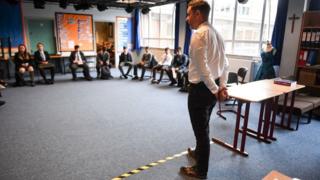Are teachers more at risk of coronavirus?

Children in England and Wales are due to go back to the classroom in September.
In Scotland, where pupils have already returned, 21 staff at a Dundee school have been linked to a cluster of coronavirus cases – raising concerns about the safety of teachers.
Are teachers at higher risk?
While children are extremely unlikely to be made ill by coronavirus, adult staff are at greater risk.
A Public Health England study, carried out when many schools had not yet re-opened, suggested staff were more likely to catch the virus from each other, or from elsewhere, than they were from pupils.
It recommended staff be vigilant about coronavirus outside of school and that care should be taken in areas like common staff rooms when at work.
The government says it does not regard schools as high-risk workplaces. Even clinically extremely vulnerable staff are expected to return, provided measures such as social distancing and extra handwashing are followed.
But public sector union Unison says social distancing in schools will ”realistically be very difficult”. It says little personal protective equipment has been provided, meaning schools will be less protected than other workplaces.
School staff should be allowed to wear face coverings, it argues, and vulnerable staff should be able to request an individual risk assessment. In Scotland, face coverings must now be worn in corridors and communal areas of secondary schools, and on school transport by anyone over five.
How dangerous is coronavirus for children?
Children of all ages are at extremely low risk of becoming ill from the virus.
Adults – particularly older adults – are far more likely to be seriously ill and die from complications.
The UK’s chief medical adviser, Prof Chris Whitty, has said “the chances of children dying from Covid-19 are incredibly small”.
According to the Office for National Statistics, there were 10 deaths recorded as “due to Covid-19” among those aged 19 and under in England and Wales between March and June. There were 46,725 deaths among those aged 20 and over.
And in a study of more than 55,000 coronavirus patients in hospitals, less than 1% were under the age of 19.
There have been some cases of younger children developing an inflammatory syndrome similar to Kawasaki disease. Scientists are exploring a possible delayed immune response to coronavirus – but these are extremely rare.
- Missing school is ‘worse than virus for children’
- How will schools reopen in September?
- Pubs ‘may need to shut’ to allow schools to reopen
Can children pass on coronavirus to others?
A review of global studies by University College London (UCL) and the London School of Hygiene and Tropical Medicine found children were about half as likely to catch coronavirus as adults, meaning they would be less likely to pass it on.
The team reviewed more than 6,000 studies from around the world but found only 18 had good enough data.
The Public Health England study suggested there were ”very few” cases of transmission between school staff and students, although there was little data available for secondary schools.
The government’s Scientific Advisory Group for Emergencies (Sage) said in countries where schools have reopened, data suggests it has made “little difference to community transmission”.
Teams of researchers around the world have tried to estimate how often children catch coronavirus and how often they are the first case which starts an outbreak.
Studies of clusters of infections in family groups across China, and cases in the French Alps, have concluded – based on contact tracing – that none of the infections were likely to have been introduced by children.
Community studies in Iceland, South Korea, Netherlands and Italy all found evidence children were less likely to have – or have had – the virus than adults. The Italian region in the study tested 70% of its population.
A review of the evidence by a global team of researchers concluded: “The role of children in transmission is unclear, but consistent evidence is demonstrating a lower likelihood of acquiring infection, and lower rates of children bringing infections into households.”
What if you don’t send schoolchildren back?
Opening schools involves some risk of spreading infection, but not opening schools also involves risk – just of a different kind.
Prof Chris Whitty, who is also England’s chief medical officer, says children are more likely to be harmed “in the long run” by not returning to school than if they catch coronavirus.
He also said there were “no risk-free options” and it was important for parents and teachers to understand both the risks and benefits as schools reopen.
Sage says school closures risked children’s educational outcomes, which in turn could impact their psychological wellbeing and long-term development. This is likely to hit the most vulnerable children the hardest.
When some schoolchildren returned earlier in the summer, younger year groups and those with exams coming up were generally prioritised.
This is because they have the most important educational needs and, for younger children, they may be less able to learn well at home.
What do I need to know about the coronavirus?
- EASY STEPS: What can I do?
- CONTAINMENT: What it means to self-isolate
- UK LATEST: What’s the UK’s plan and what could happen next?
- MAPS AND CHARTS: Visual guide to the outbreak
- VIDEO: The 20-second hand wash
- Coronavirus pandemic
- Social distancing
- Children
Source: Read Full Article
